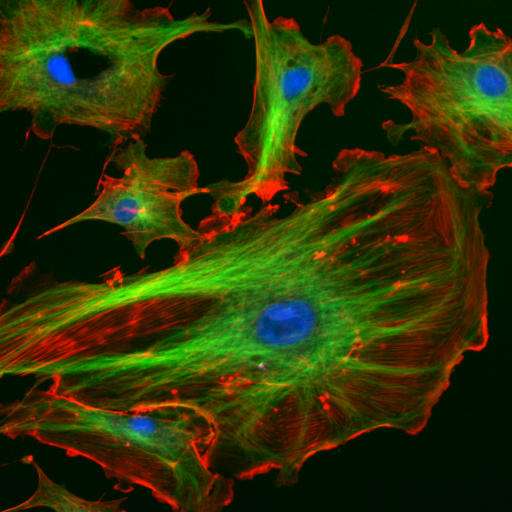May 20, 2016 report
CLIP-170 microtuble found to bind tightly to formins to accelerate actin filament elongation

(Phys.org)—A team of researchers at Brandeis University in Massachusetts, has found that the CLIP-170 microtuble found in cells, which had been known to be important in cytoskeleton development, binds tightly to formins to accelerate actin filament elongation. In their paper published in the journal Science, the team describes their experiments with adding a fluorescent protein to the microtubule to better understand the roll CLIP-170 plays in actin flament assembly. In a Perspective piece on the work done by the team, Klemens Rottner with Universität Braunschweig in Germany also explains the role played by microtubules and actin filaments in the development of the eukaryotic cytoskeleton (the material that holds the shape of cells.)
In order for a cell to hold its shape, filaments must grow to the size needed to provide support, similar in some respects to the cartilage found in the nose and other parts of the body. But, in order for the cell to grow to the proper size and shape it needs to be to hold all its components, some type of mechanism must be in place to regulate the growth. Prior research has shown that microtubules serve that purpose, but how the process works, has remained somewhat murky. In this new effort, the researchers found that the CLIP-170 microtuble actually binds very tightly to a protein known as formin, and in so doing is able to play a role in determining how long an actin filment will grow—or more specifically, to actually accelerate elongation.
To learn more about the role that CLIP-170 plays in cytoskeleton development, the researchers applied a fluorescent protein to some of them in their lab, and then watched what happened using single cell microscopy during cell maturation. In addition to accelerating actin filament elongation, the team observed it along with mDia1 dimers, tracking filament ends and promoting polymerization (causing it to grow approximately 18 times faster than growth without it), which provided a protective cap. They also found that using another technique allowed them to watch as the mDia1/CLIP-10 complexes were coaxed into action by microtubule ends, which resulted in rapid filament growth. They note that such filament growth is most particularly necessary for dendrite growth in neurons.
More information: J. L. Henty-Ridilla et al. Accelerated actin filament polymerization from microtubule plus ends, Science (2016). DOI: 10.1126/science.aaf1709
Abstract
Microtubules (MTs) govern actin network remodeling in a wide range of biological processes, yet the mechanisms underlying this cytoskeletal cross-talk have remained obscure. We used single-molecule fluorescence microscopy to show that the MT plus-end–associated protein CLIP-170 binds tightly to formins to accelerate actin filament elongation. Furthermore, we observed mDia1 dimers and CLIP-170 dimers cotracking growing filament ends for several minutes. CLIP-170–mDia1 complexes promoted actin polymerization ~18 times faster than free–barbed-end growth while simultaneously enhancing protection from capping proteins. We used a MT-actin dynamics co-reconstitution system to observe CLIP-170–mDia1 complexes being recruited to growing MT ends by EB1. The complexes triggered rapid growth of actin filaments that remained attached to the MT surface. These activities of CLIP-170 were required in primary neurons for normal dendritic morphology. Thus, our results reveal a cellular mechanism whereby growing MT plus ends direct rapid actin assembly.
Journal information: Science
© 2016 Phys.org
















